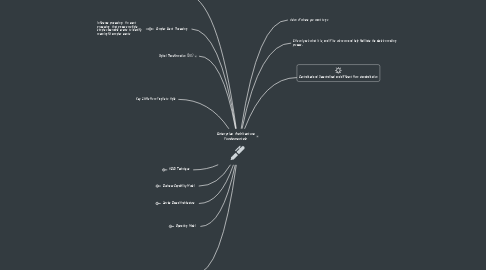
1. Key Shifts from Fragile to Agile
2. Digital Transformation (DX)
3. Business Capability Model
3.1. First Iteration Level 1-2 of decomposition
3.2. Second Iteration adding 2-3 addition levels of decomposition, the Conceptual Data Model to the BCM (Separate artefact
3.3. Service Business Capability Model - add service container boundaries to the architectural level model and includes mapping the Logical Model to the BCM
3.4. Design Principles
3.4.1. What not how or who
3.4.2. Wholistic covering the complete business
3.4.3. Independent of a particular organizational or job design
3.4.4. Enterprise approaches are adopted
3.4.5. Generic design approaches are adopted
3.4.6. Maximum Depth of level 5
3.4.7. Planning and Design views
3.4.7.1. Each leaf capability must have a minimum of 2 services
3.5. Capability Naming Standards
3.5.1. nouns not verbs, capability name only occurs once, use localized terminology
3.6. General Approach
3.6.1. gather information
3.6.1.1. existing EA documentation
3.6.1.2. process maps and/or value chains
3.6.1.3. org structure
3.6.1.4. current outsourcing arrangments
3.6.1.5. executive interviews
3.6.1.6. IF4IT
3.6.1.7. existing application document
3.6.1.8. governmental or regulatory requirements
3.6.1.9. conceptual data model
3.6.1.10. experience
3.6.1.11. Online
3.6.1.11.1. org website
3.6.1.11.2. Wikipedia
3.6.1.11.3. software vendors product information/web sites
3.6.2. pattern recognition
3.6.3. produce draft diagram
3.6.4. Map conceptual data model to the draft BCM
3.6.5. Issue draft diagram and review and reissue if changed
3.6.6. produce starting point capability descriptions
3.6.7. issue starting point capability descriptions to owners of capability and askthem to loalize it
3.6.8. update all descriptions based on the feedback
3.7. BCM Background
3.7.1. modular programming 80s
3.7.2. functional decomposition late 80/90s
3.7.3. component based development 90s/00s
4. Service Based Architecture
4.1. SOA/SBA Introduction
4.1.1. User Interface
4.1.1.1. channels, portals,
4.1.2. Business Process Layer
4.1.2.1. cross capability e2e
4.1.2.1.1. Process (Process Orchestration)
4.1.3. Service Layer
4.1.3.1. How do you deliver services and what do you require to do that?
4.1.3.1.1. Service Orchestration
4.1.3.2. Microservices
4.1.3.2.1. not a really good definition
4.1.4. Service Based
4.1.4.1. Disaggregation of the Business Model
4.1.4.1.1. Industry deconstruction
4.1.4.1.2. move to market services
4.1.4.1.3. enterprise reconstruction
4.1.4.1.4. outsourcing
4.1.4.1.5. blurring where org/enterprise boundary lies
4.1.4.2. Responsiveness
4.1.4.3. Increasing Market Segmentation
4.1.4.4. Why
4.1.4.4.1. Application Centric Approach is problematic - Islands of data create Information Fidelity, business process fragmentation
4.1.5. Solution Layer
4.1.5.1. apps, sware, manual tasks, how do the solutions automate the services
4.1.6. Technology Layer
4.1.6.1. hardware, network
4.2. Benefits
4.2.1. faster time to market, reduced cost, business adaptability,
4.3. Business Process Management
4.3.1. discipline initial process design, implementation, control, analytics and improvement
4.3.2. BPMS - realtime visibility monitoring, optimization, e2e, auto and manual process
4.3.2.1. SOA Notes, process diagrams using BPMN: Business Processing Modelling Notation
4.3.2.2. Business Process Execution Language (automatic)
4.4. Case for BPM/SOA
4.5. Case studies
5. ABCD Technique
5.1. Background
5.2. Rationale: outcomes driven, lean principles, clear scope, traceable and realistic outcomes, multi disciplined team, collaboration.
5.3. 4 Places of Thought
5.3.1. Where are we now?
5.3.2. Where do we want to go?
5.3.3. What do we need to get there?
5.3.4. How do we make it happen?
5.4. ABCD Perspectives
5.4.1. A Issues, B outcomes used for
5.4.1.1. financial outcome
5.4.1.2. Partner experience
5.4.1.3. Customer Experience
5.4.1.4. staff experience
6. Operating Model
6.1. How we will complete
6.1.1. Focus on Values and purpose of what you will and won't do - the guiding operating philosophies and principles
6.1.2. Competitive Triangle (Product, Service, Cost) - compete in 2 but not 3 ie: Apple
6.1.3. What is your Mission - Why, How & What Model
6.2. Operating Model
6.2.1. Replication - ie: Shake Shack same fanchise everywhere
6.2.1.1. Implications - independent transactions but same service provision and operations are similar
6.2.2. Diversification - ie. Conglomerates of autonomous profit centers
6.2.2.1. most IT investments are S/BUs its operations
6.2.3. Unifications - standard services Qantas, Dow Corning
6.2.3.1. shared customers and partners, organization wide processes are centralized
6.2.4. Co-ordination - some capabilities are standardized across BUs others are unique ie. all Banks were forced to move from diversification to Co-ordination by regulators
6.2.4.1. 75% in the market are in this operating model, standard customers and supplier data
6.3. Architecture Implications
6.4. Corporate Values
6.5. Value proposition
6.5.1. an innovation, service or product intended to make the org attractive to the market
6.6. Agile Including Operating Model
6.6.1. the organization must understand its operating model
6.7. Matrix of of Business Operating Model
7. enterprise architecture
7.1. Agile
7.1.1. Adaptable
7.1.2. Flexible
7.1.3. Responsive
7.2. Integrated Architecture Framework
7.2.1. Business Intent
7.2.2. Business Design
7.2.3. People Design
7.2.4. Technology Design
7.3. Business Capability Model
7.3.1. BPM Overview
7.3.1.1. BPM
7.3.1.2. BPMS
7.3.1.2.1. BPEL - Business Process Execution (Language)
7.4. Target State Solutions Architecture - what do we need to get there?
7.4.1. Strategic Planning/Roadmap Development Process
7.4.1.1. Stage 1: Understand the organization does (Planning)
7.4.1.1.1. What good looks like (issues to rectify)
7.4.1.1.2. what capabilities will be standardized?
7.4.1.2. Stage 2:
7.4.1.2.1. Understand what it does
